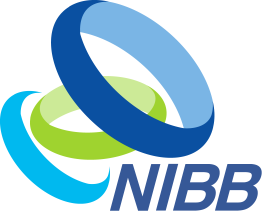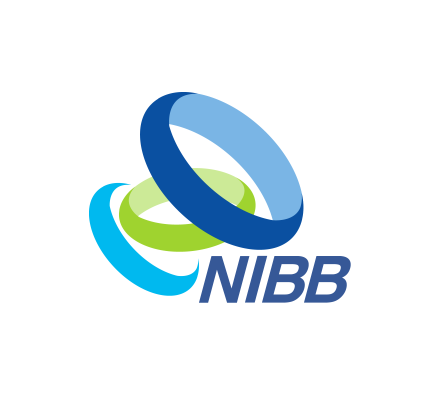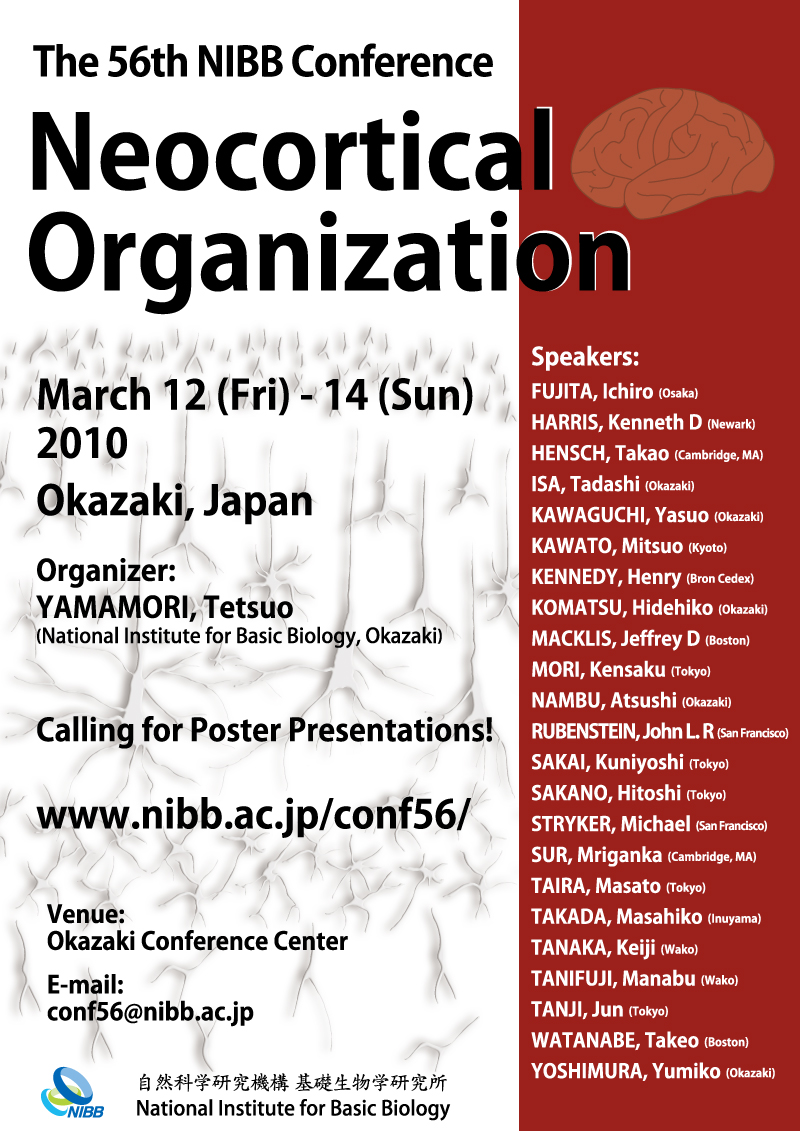
基礎生物学研究所




| Organizers | Tetsuo Yamamori (NIBB) |
|---|---|
| Venue | Okazaki Conference Center, Okazaki, Japan |
| Date | Mar. 12-14, 2010 |
| Link | オフシャルサイト (http://www.nibb.ac.jp/conf56/) |
| Poster |

|

「大脳皮質」
大脳新皮質は哺乳類にみられる固有の脳構造であり、知覚や行動をつかさどる中枢だと考えられている。そのため、100年以上にわたり神経科学における研究の主流となってきたのだが、その形成機構や、機能機序が分子レベルで分かってきたのはごく最近の事である。そこで大脳新皮質構築研究に関して、二つの側面において交流が進むよう、触媒的な会議を開く良い時期だと考えた。一つの側面は大脳新皮質構築の機能的、遺伝学的な研究間の交流であり、もう一つはこの分野で世界最先端の研究を行っている国内外からの著名な研究者達の交流の機会を提供することである。このシンポジウムは5つのセッションから構成された。
セッション1:皮質ニューロンの特異性の形成機構
セッション2:視覚および聴覚システムにおける皮質ネットワークの機能構築
セッション3:霊長類およびヒトにおける皮質ネットワークの機能構築
セッション4:運動制御およびその解剖学的、生理学的基礎
セッション5:高次認知機能および表出
シンポジウムは無事盛況に終了した。最後のセッションでのカリフォルニア大学サンフランシスコ校 マイケル・ストライカー教授による結びの言葉を引用したいと思う。
「国際会議とは極めて有益で、そして楽しくなりうるものである。今回の会議はお互いに論文を読みあうのと同じくらいの時間をかけても、得るものはずっと大きい会議である。一つには、質疑応答を通して、自分達が誤解しているかもしれない事について確認したり、論文に乗っているデータだけでは証拠が足りないと思うことについて問い合わせることができる。このような討論をすれば、さらなる実験や、違った角度からの解析につながるかもしれないし、単に不明な点が解消するだけの場合もある。それだけではない。それぞれの将来の計画について聞き、理解し、議論を行うことで、自分たち自身の今後の研究を改善することにもなる。また研究仲間たちが創りだした新しい研究ツールについて知ることもできる。特にポスターセッションは、私達外国人がエネルギーにあふれた若く優秀な日本人学生研究者らに会う機会でもあるし、逆に彼らが我々に会う機会でもある。このような機会は、今後の科学的交流やポスドク研究のための基盤を築くものである。最後に、神経科学の発展を刺激するような会議を開いてくれた基礎生物学研究所と山森教授に感謝の意を表し、日本と欧米間の交流を祝して締めの言葉としたい。Arigato。」 (山森 哲雄)
| March 12 (Fri) at Okazaki Conference Center | |
| 09:00-09:10 | Opening Remarks Tetsuo Yamamori (NIBB, Japan) |
| Session 1 Formation of Cortical Neural Specificity | |
| 09:10-09:55 | “Activation and Inhibition of FGF-Signaling Mechanisms That Control Cortical Patterning” |
|
John L. R. Rubenstein (UCSF, USA)
|
|
| 09:55-10:40 | “Neural Map Formation in the Mouse Olfactory System” |
| Hitoshi Sakano (Univ. Tokyo, Japan) | |
| 10:40-10:55 |
Coffee Break
|
| 10:55-11:40 | “Parallel Mitral- and Tufted-Cell Streams in the Central Olfactory System” |
| Kensaku Mori (Univ. Tokyo, Japan) | |
| 11:40-12:25 | “Molecular Logic of Neocortical Projection Neuron Development and Repair” |
| Jeffrey D. Macklis (Harvard Univ., USA) | |
| 12:25-13:30 |
Lunch
|
| 13:30-13:45 | “Spatiotemporal Post-Transcriptional Regulation of Cyclin D2 mRNA Induces Asymmetrical Cell Fates in Neuroepithelial Cells and Self-Organization of Corticogenesis” |
| Noriko Osumi (Tohoku Univ., Japan) | |
| 13:45-14:30 | “Cortical Neuron Diversity and Local Connection Selectivity” |
| Yasuo Kawaguchi (NIPS, Japan) | |
| Session 2 Functional Organization of the Cortical Networks in the Visual and Auditory Systems | |
| 14:30-15:15 | “Critical Period Plasticity in the Visual and Auditory Systems” |
| Takao Hensch (Harvard Univ., USA) | |
| 15:15-15:30 |
Coffee Break
|
| 15:30-16:15 | “Cell-Specific Circuits and Plasticity in Visual Cortex” |
| Mriganka Sur (MIT, USA) | |
| 16:15-17:00 | “How Neural Activity and Molecular Cues Guide the Formation of Cortical Maps and Connections Between Brain Areas” |
| Michael P. Stryker (UCSF, USA) | |
| 17:00-17:20 | “Difference in Binocularity and Ocular Dominance Plasticity Between GABAergic and Excitatory Cortical Neurons, as Revealed by In Vivo Two-Photon Functional Ca2+ Imaging” |
| Tadaharu Tsumoto (RIKEN BSI, Japan) | |
| 17:20-17:35 |
Coffee Break
|
| 17:35-18:20 | “Activity Dependent Maturation of Functional Local Circuits” |
| Yumiko Yoshimura (NIPS, Japan) | |
| 18:20-19:05 | “Organization of Spiking Activity in Neuronal Populations of Auditory Cortex” |
| Kenneth D. Harris (Imperial College London, UK) | |
| March 13 (Sat) | |
| Session 3 Functional Organization of the Cortical Networks in Primates and Humans | |
| 09:00-09:45 | “Principles of Interareal Cortical Networks” |
| Henry Kennedy (Inserm U846, France) | |
| 09:45-10:30 | “Analysis of Cortical-Area Specific Gene Expressions in the Old World Monkey Reveals Large Domain Structures in the Primate Neocortex” |
| Tetsuo Yamamori (NIBB, Japan) | |
| 10:30-10:50 |
Coffee Break
|
| 10:50-11:35 | “Diversity of Pyramidal Neurons Across Neocortical Areas in the Primate: Biophysics, Morphology, and Postnatal Development” |
| Ichiro Fujita (Osaka Univ., Japan) | |
| 11:35-12:20 | “Hierarchically Organized ‘Functional Structures’ in Monkey Inferior Temporal Cortex” |
| Manabu Tanifuji (RIKEN BSI, Japan) | |
| 12:20-13:30 |
Lunch
|
| 13:30-14:15 | “Color Processing in Higher Cortical Areas of the Monkey” |
| Hidehiko Komatsu (NIPS, Japan) | |
| 14:15-15:00 | “Perceptual Learning as a Result of an Exposed Feature Being Internally Enhanced” |
| Takeo Watanabe (Boston Univ., USA) | |
| 15:00-15:20 |
Coffee Break
|
| Session 4 Motion Control and the Anatomical and Physiological Basis | |
| 15:20-16:05 | “Contrast in the Use of the Supplementary and Pre-Supplementary Motor Areas of Primates” |
| Jun Tanji (Tamagawa Univ., Japan) | |
| 16:10-18:10 | Poster Session List of Poster titles |
| 18:30-20:30 |
Social Meeting (Banquet)
|
| March 14 (Sun) | |
| 09:00-09:45 | “Cortico-Basal Ganglia Loop and Movement Disorders” |
| Atsushi Nambu (NIPS, Japan) | |
| 09:45-10:30 | “Cerebral Network for Behavioral Control: Parietal/Temporal-Prefrontal-Motor Links” |
| Masahiko Takada (Kyoto Univ., Japan) | |
| 10:30-10:50 |
Coffee Break
|
| 10:50-11:35 | “Cortical Compensatory Mechanism After Spinal-Cord Injury” |
| Tadashi Isa (NIPS, Japan) | |
| 11:35-12:20 | “Neural Mechanisms for Navigation” |
| Masato Taira (Nihon Univ., Japan) | |
| 12:20-13:30 |
Lunch
|
| Session 5 Higher Cognition and the Representation | |
| 13:30-14:15 | “Functional Differentiation among Primate Prefrontal Areas in Goal-Directed Behavior” |
| Keiji Tanaka (RIKEN BSI, Japan) | |
| 14:15-15:00 | “Finding Common and Concise Representation for Brain, Body and Environment” |
| Mitsuo Kawato (ATR, Japan) | |
| 15:00-15:45 | “The Foundation of Human Language” |
| Kuniyoshi L. Sakai (Univ. Tokyo, Japan) | |
| 15:45-16:00 | Concluding Remarks |
| Michael P. Stryker (UCSF, USA) | |